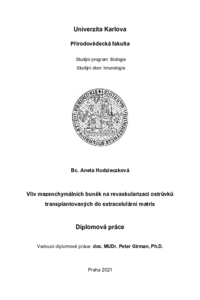Vliv mezenchymálních buněk na revaskularizaci ostrůvků transplantovaných do extracelulární matrix
Impact of mesenchymal stem cells on islets revascularization after transplantation into the extracellular matrix
diplomová práce (OBHÁJENO)

Zobrazit/
Trvalý odkaz
http://hdl.handle.net/20.500.11956/150907Identifikátory
SIS: 220339
Kolekce
- Kvalifikační práce [20329]
Autor
Vedoucí práce
Oponent práce
Černý, Jan
Fakulta / součást
Přírodovědecká fakulta
Obor
Imunologie
Katedra / ústav / klinika
Katedra buněčné biologie
Datum obhajoby
13. 9. 2021
Nakladatel
Univerzita Karlova, Přírodovědecká fakultaJazyk
Čeština
Známka
Dobře
Klíčová slova (česky)
diabetes 1. typu, ostrůvky, revaskularizace, mezenchymální stromální buňky, extracelulární matrix, endoteliální buňkyKlíčová slova (anglicky)
diabetes type 1, islets, revascularization, mesenchymal stromal cells, extracellular matrix, endothelial cellsTransplantace pankreatu představuje jedinou možnou dosavadní léčbu pro navození nezávislosti na exogenně podávaném inzulínu u pacientů s diabetem mellitem 1. typu. Hlavní limitací transplantací je však nedostatek dárcovských orgánů. Z tohoto důvodu je předmětem výzkumu příprava bioarteficiálních orgánů na základě buněčné terapie. Pro jejich přípravu se využívají části extracelulární matrix, jež se získávají decelularizací pankreatu. Takto připravená proteinová lešení jsou poté opět repopulována různými typy buněk. Extracelulární matrix poskytuje buňkám strukturální podporu, zprostředkovává signalizaci pro diferenciaci, proliferaci nebo migraci. Mezenchymální stromální buňky se využívají v klinické terapii, mají pozitivní vliv na regenerační procesy tkáně, modulační funkci extracelulární matrix, potlačují zánět a podporují angiogenezi. Decelularizacemi pankreatů jsme získali extracelulární matrix, které jsme osídlili ostrůvky a mezenchymálními buňkami, v druhém případě navíc i endoteliemi. Tyto bioarteficiální pankreaty (skelety) jsme poté transplantovali syngenním diabetickým potkanům do podkoží za účelem sledování revaskularizace ostrůvků. Na základě řezů explantovaných skeletů jsme zjistili, že bez přítomnosti endotelií v transplantovaném skeletu proběhla revaskularizace ostrůvků lépe. Klíčová...
Pancreatic transplantation is the only possible treatment to induce independence from exogenous insulin administration in type 1 diabetes mellitus. However, the shortage of donor organs remains the main limitation of pancreas transplantations. The goal of the research is the preparation of a bioartificial organ based on cell therapy. Parts of the extracellular matrix obtained by decellularization of the pancreas are used for its preparation. The protein scaffolds prepared in this way are then repopulated by different cell types again. The extracellular matrix provides structural support to cells, mediates signaling for differentiation, proliferation or migration. Mesenchymal stromal cells are used in clinical therapy, have a positive effect on tissue regeneration processes, modulating the function of the extracellular matrix, suppress inflammation and promote angiogenesis. After pancreas decellularization, we repopulated the extracellular matrix with islets, mesenchymal cells and endothelial cells. Then, the pancreas was transplanted subcutaneously into syngeneic diabetic rats to observe islet revascularization. Based on sections of explanted scaffolds, we found out that revascularization of the islets was higher without the endothelial cells in the transplanted extracellular matrix. Key words:...
